Klymit Insulated Double V

Comfortable, warm sleeping, albeit heavy pad for two.
Pros
- Wide—47"
- Warm—temps down to 20 are no problem, even with a quilt or backless bag
- Durable fabric
- Comes with inflation sack
- Not as loud as many other pads
Cons
- Does not pack down well
- Heavy
- Takes a lot to inflate with inflation sack
- Deep welts let cold air in
- Not dual chambered, so both sleepers get the same density
- Single point of failure will allow both campers to share a miserable nights sleep on the ground
We currently own three double sleeping pads. Two Klymits—this insulated one, an uninsulated, and an Exped SynMat HL Duo. If you as a couple can handle canoeing/tandem kayaking/tandem bicycling, then a double pad is for you. The double pads are warmer (no space between for cold air to come up), don't move around as much as singles and make sharing a double quilt much more enjoyable. I've tried couplers like that with the EE accomplice and the best, the Nemo Tango Duo slip cover. But those are still not as good as 1 double pad. The only downsides are having a single source of failure (both sleepers are on the ground) and bulkiness of the double.
We bought the insulated Klymit after enjoying the uninsulated one, but freezing in 40 degree temps. The Klymits work for us, but bear in mind, I'm, 5'10", 150 lbs and my wife is 5'2" 110 lbs. We don't bottom out on either Klymit. We can both sleep on our sides and our hips will not touch the ground. But when we toss and turn, if you have a lot of weight concentrated on one area, you may bottom out. I tested this out with some 8-lb weights—you can see the results. So, if you sit on the pad, you may bottom out; all spread out, you should be fine—up to a certain weight.


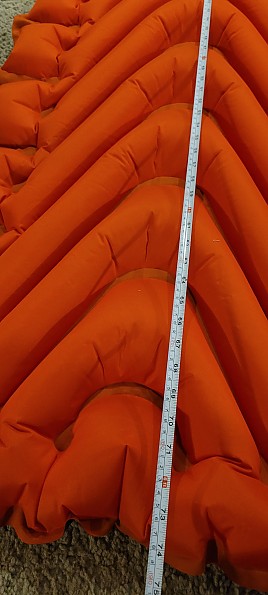
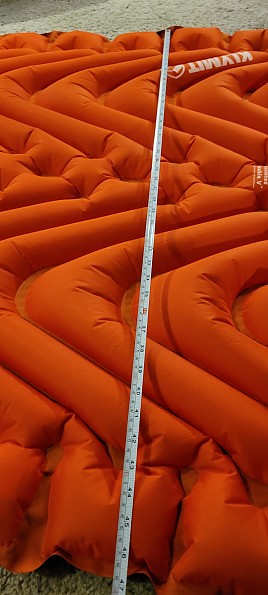
Here is where the pad is not fun—inflation. 8-10 pumps is what is advertised. We have never been able to get it inflated in 8-10 pumps. 16-17 is more realistic. When in the cramped quarters of a small tent, this becomes a challenge. The Exped Schnozzel with our Exped is 8-10. But it's a much bigger inflation bag and a smaller pad. The inflation and deflation valves are difficult to open and close—unless you wet down, or use some lip balm. A little chapstick seem goes a long way in opening and closing the valves.

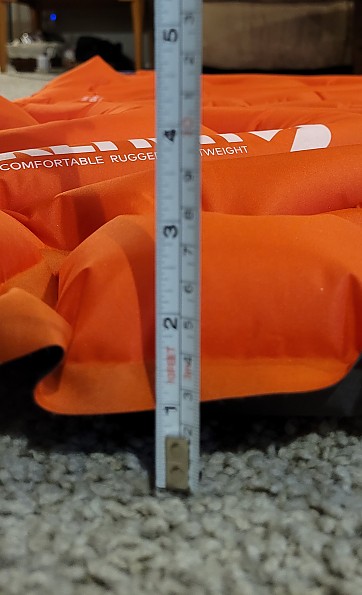
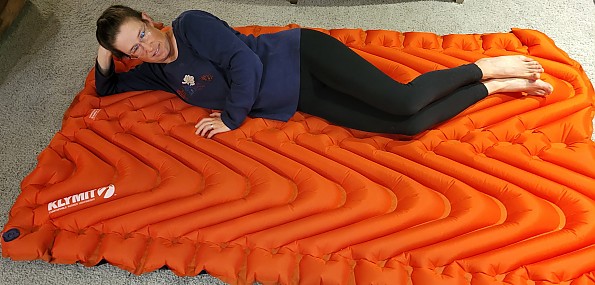
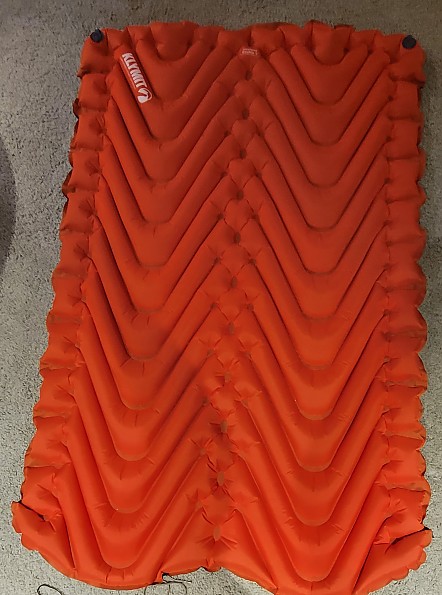
The pad's Achilles heel is its weight and packed size. The tradeoff is a much more durable pad.


We love our Exped Synmat, but realize its narrow (tapered) and much thinner material, so its durability is much less than the Klymit. So when miles don't matter—sleeping in the back of the car, car camping, short backpacking trips—the Klymits are our go-to pads. We both have back issues, and both of us have 0 issues sleeping on these pads.
When flipping over and moving around, you will make some noise. But it's not enough to wake us from a deep sleep. And it's nowhere near the potato chip bag sound of others. The Exped has two chambers—one per side. Both Klymits do NOT. This means both sleepers will have the same firmness. And the lighter of the two (assuming there is a weight difference), will have a firmer sleep due to the air distribution.
We've used this pad for at least 20 nights and never had a problem with deflating overnight. However, we have had to top it off after a night or two. Usually not a big deal, unless you open the deflate instead of the inflate valve :(
The spec R of 4.4 is not real world . Our Exped is warmer even though it has a lower spec for the R. The deep welds compress the insulation and I suspect this is where it gets cold. According to Klymit, your bag's bottom insulation should take up these spaces and not compress, therefore your sleeping bag is more efficient... I don't believe this statement in real world use. It will be interesting to see if they re-test this pad for the ASTM, I doubt it would keep its 4.4 value, but it seems fine down to 20 degree temps. ASTM R-Value - Klymit
Background
I started sleeping on closed cell foam in the '80s. Graduated to self inflating that we used for 10 years. Now, with both wife and I getting older, we have moved to inflatables. We've owned Big Agnes, Klymit, and Exped pads.
Source: bought it new
Price Paid: $100
Your Review
Where to Buy
You May Like
Specs
| Price |
MSRP: $169.99 Current Retail: $179.99 Historic Range: $93.85-$179.99 Reviewers Paid: $100.00 |
| Weight |
52.8 oz / 1497 g |
| Material |
75D polyester |
| Dimensions |
74 x 47 x 3 in / 188 x 119 x 8 cm |
| Packed Dimensions |
12 x 7 in / 30 x 18 cm |
| R-Value |
4.4 |



